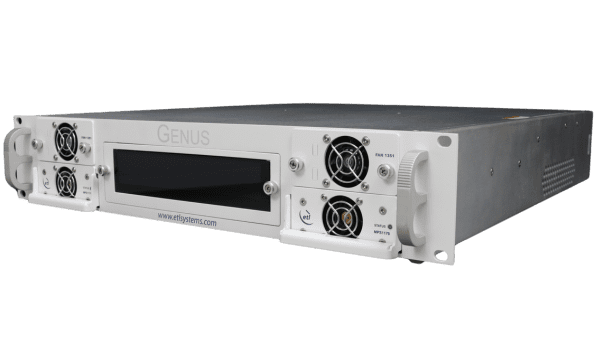
Genus Habitat
A modular and flexible smart chassis solution

GENUS Habitat
Compact, modular, and future-ready RF distribution
The GENUS smart chassis by ETL Systems represents the latest advancement in chassis technology, offering a compact, modular, and flexible solution for growing teleport operators. Available in 1U, 2U, and 3U rack sizes, the GENUS chassis can accommodate up to 17 RF distribution modules, allowing operators to customise their setup according to their specific needs. This modularity provides a high degree of adaptability, making the GENUS smart chassis an ideal choice for operators looking to scale their operations efficiently and effectively.
The smart chassis concept allows for the housing of multiple RF modules within the same shelf, providing space savings, reduced costs, and increased rack space efficiency. The GENUS smart chassis offers improved overall RF performance and introduces new features such as hot-swappable components, expanded compatibility with RF modules, enhanced security protocols, and improved local control and monitoring capabilities via a front panel touchscreen interface.

Advanced control & security

Space and cost efficiency

Enhanced flexibility

Secure remote control & monitoring
The GENUS habitat offers improved security aspects (SNMPv3 and HTTPS) while maintaining an industry-leading module density, with 17 module slots available in the 1U chassis. These upgrades make GENUS a highly secure and efficient solution for demanding applications.

Save rack space & cost
The GENUS chassis integrates StingRay RF over Fibre, ETL’s Falcon frequency converters, ALTO amplifiers, switches, splitters, and small RF matrices/routers, all within a single indoor or outdoor chassis. This consolidation reduces costs, saves rack space, and enhances system resilience.
These advancements ensure that the GENUS smart chassis not only meets current operational demands but also anticipates future technological requirements.

Easy Customisation
and Adaptation
The GENUS habitat is modular, allowing for easy customisation and adaptation to specific RF distribution requirements. Operators can populate the chassis with a variety of RF modules, such as Frequency Converters, Splitters, RF Over Fibre modules, and more.
Compact, Space Saving Design
Available in 1U, 2U, and 3U rack sizes, the GENUS habitat is compact, saving valuable rack space in teleport operations.


Advanced Security
With improved security protocols such as SNMPv3 and HTTPS, the GENUS smart chassis enhances data protection and network security.
Learn more about this product range
Get in touch with our sales team to learn how our RF and Digital IF products could work for you.
Features and Benefits of the GENUS Habitat

Flexibility
Operators can configure the GENUS chassis to meet their exact RF distribution needs, ensuring optimal performance and efficiency.

Space Saving
The smart chassis concept enables multiple RF modules to be housed within the same shelf, reducing the overall footprint and maximising space utilisation.

Cost Reduction
By providing space savings and offering hot-swappable components, the GENUS range reduces running costs and enhances maintenance efficiency.

Enhanced Compatibility
The GENUS range introduces new compatible RF modules, expanding the range of options available for operators.

Improved Performance
The GENUS smart chassis boasts improved overall RF performance compared to previous models, ensuring high-quality signal management.

User Friendly Interface
The HMI touchscreen provides improved local control and monitoring capabilities, making it easier for operators to manage their ground segment setup.
Modules
5 Chassis Available:
1U, 2U, 3U, ODU, Benchtop
The GENUS chassis range offers versatile solutions across various form factors, including 1U, 2U, 3U, outdoor (ODU), and benchtop configurations. Designed to meet diverse operational needs, these chassis provide robust housing for ETL’s advanced modules, supporting applications ranging from satellite ground stations to telecommunications infrastructure. Each form factor is meticulously engineered to optimise space utilisation, enhance operational efficiency, and ensure seamless integration within different environments, making the GENUS habitat a reliable choice for critical RF and power distribution applications.
Chassis
- Modular Architecture: Can house different types of modules (e.g., fibre, amplifier) within the same chassis.
- Space Saving: Eliminates the need for multiple chassis for different types of modules.
- Commonality of Spares: Uses the same power supply units (PSUs) and central processing units (CPUs) across different chassis types.
- Unified Protocol and Commands: Consistent protocol and software commands across multiple chassis types.
- Standardised Webpage: Uniform interface across all platforms for ease of use.
- Hot Swappable RF Modules: Allows for the replacement of RF modules without powering down the system.

Hot Swappable Modules
Hot swappable modules offer significant benefits in ground segment systems by enabling the replacement or upgrade of hardware components without interrupting service or powering down equipment.
This feature is crucial for maintaining continuous operation, particularly in mission-critical environments such as satellite communication, where downtime can lead to data loss or disruption of services. Hot swappability ensures swift and efficient maintenance, reducing repair times and operational costs while enhancing system reliability and uptime. Additionally, it allows for easy scalability and flexibility, enabling ground stations to adapt quickly to changing technology and capacity requirements.

Secure protocols with SNMPv3 and HTTPS
Implementing secure protocols like SNMPv3 and HTTPS in network management provides substantial benefits by ensuring the safety and integrity of data communications. SNMPv3 (Simple Network Management Protocol version 3) enhances security through robust authentication and encryption mechanisms, protecting network devices from unauthorised access and tampering. It also supports fine-grained access control, allowing administrators to precisely manage user permissions.

Meanwhile, HTTPS (Hypertext Transfer Protocol Secure) encrypts data transmitted over the internet, safeguarding sensitive information from interception and attacks during remote access and control of network devices. Together, these protocols help protect critical infrastructure from cyber threats, enhance compliance with security standards, and foster trust in network management practices. By securing both local and remote communication channels, they provide a resilient foundation for reliable and secure operations in modern networking environments.
Local & Remote control & monitoring
Local and remote control and monitoring capabilities provide essential advantages in managing complex systems and networks. Locally, operators can directly oversee equipment status, troubleshoot issues promptly, and make real-time adjustments to optimise performance. This immediate access is critical for maintaining operational continuity and responding swiftly to changing conditions or emergencies.

On the other hand, remote control and monitoring extend these capabilities beyond physical proximity, allowing administrators to manage devices and systems from virtually anywhere. This flexibility enhances operational efficiency by reducing the need for on-site interventions and enabling proactive maintenance and upgrades. Additionally, remote monitoring provides insights into long-term performance trends, enabling data-driven decision-making and predictive maintenance strategies. Overall, the combination of local and remote control and monitoring empowers organisations to maximise uptime, ensure regulatory compliance, and deliver reliable services to end-users.
Free Technical Support
ETL’s product support service offers comprehensive assistance to ensure optimal performance of your equipment. Customers receive free access to our UK-based technical support team, staffed by experienced engineers with in-depth knowledge of ETL products. Our support includes advice on installation, configuration, operation, and maintenance, as well as diagnostic and troubleshooting help. We also provide identification and supply of replacement parts, along with free software updates to keep systems running smoothly.

GENUS Chassis Range
1U Chassis
ETL’s GENUS 1U chassis offers exceptional flexibility with up to 17 configurable RF modules, integrated redundancy, hot-swap components, secure protocols, easy maintenance, and diverse module options.
- Modular & flexible – configurable design housing up to 17 RF modules, which can be mixed
- Integrated RF module redundancy options
- Resilience from:
- Hot-swap modules
- Dual redundant & hot-swap PSUs
- Hot-swap fans
- Field replaceable CPU and HMI
- Option for integrated internal 10MHz reference source, also field replaceable
- Future proof and secure protocols including SNMPv3 and HTTPS
- Common spares and remote interfaces across different products allows Genus chassis to be easily maintained in service
- Module options are frequency converters, matrices, RF over fibre, amplifiers, DC PSUs, switches & splitter/combiners
2U Chassis
ETL’s GENUS 2U chassis offers a compact, high performance solution with up to 17 configurable RF modules, integrated redundancy, hot-swap components, secure protocols, easy maintenance, and diverse module options.
- Modular & flexible – configurable design housing up to 17 RF modules, which can be mixed
- Integrated RF module redundancy options
- Resilience from:
- Hot-swap modules
- Dual redundant & hot-swap PSUs
- Hot-swap fans
- Field replaceable CPU and HMI
- Option for integrated internal 10MHz reference source, also field replaceable
- Future proof and secure protocols including SNMPv3 and HTTPS
- Common spares and remote interfaces across different products allows Genus chassis to be easily maintained in service
- Module options are frequency converters, matrices, RF over fibre, amplifiers, DC PSUs, switches & splitter/combiners
3U Chassis
ETL’s GENUS 3U chassis is modular and flexible, supporting up to 17 RF modules with integrated redundancy. It features hot-swap modules, power supplies, and fans, field-replaceable CPUs, and secure protocols, making it future-proof and easy to maintain.
- Modular & flexible – configurable design housing up to 17 RF modules which can be mixed
- Integrated RF module redundancy options
- Resilience from:
- Hot-swap modules
- Dual redundant & hot-swap PSUs
- Hot-swap fans
- Field replaceable CPU and HMI
- Option for integrated internal 10MHz reference source, also field replaceable
- Future proof and secure protocols including SNMPv3 and HTTPS
- Common spares and remote interfaces across different products allows Genus chassis to be easily maintained in service
- Module options are high density splitters and combiners

Datasheets
Large ODU (Outdoor Unit)
ETL’s Large GENUS ODU delivers compact, rugged performance with hot-swappable RF modules, dual redundant power supplies, and secure remote control, making it ideal for reliable, outdoor signal processing in extreme conditions.
- Houses up to 19 RF module types, which can be mixed
- Hot swappable RF modules
- IP65 outdoor rated
- Airconditioning and heater options for extended operating temperatures
- Dual redundant, hot swap power supplies
- Field replaceable CPU and HMI
- Optional user replaceable Internal 10MHz source/distribution card
- Secure protocols with SNMPv3 and HTTPS
- Remote control & monitoring via RJ45 Ethernet port and web browser interface
- Optional local control touchscreen HMI
Small ODU (Outdoor Unit)
ETL’s Small ODU unit is a compact, IP65-rated outdoor chassis that houses up to 8 mixed RF modules with 1+1 redundancy and hot-swappable capabilities, featuring dual DC power inputs, secure protocols, and remote control via Ethernet and web interface.
- Compact outdoor chassis
- Houses up to 8 RF module types, which can be mixed
- 1+1 redundancy options
- Hot swappable RF modules
- IP65 outdoor rated
- Dual DC power inputs
- Field replaceable CPU
- Internal user replaceable 10MHz source/distribution card
- Secure protocols with SNMPv3 and HTTPS
- Remote control & monitoring via RJ45 Ethernet port and web browser interface

Datasheets
Benchtop
ETL’s GENUS Benchtop offers portable, modular, hot-swappable components, making it ideal for comprehensive satellite communications, high-performance testing and scientific research applications.
- Local control via optional touchscreen HMI
- Compact and easily transportable by hand
- Houses up to 10 hot swappable RF module types,
which can be mixed - User replaceable CPU
- Optional Internal 10MHz source/distribution card
- Secure protocols with SNMPv3 and HTTPS
- Remote control & monitoring via RJ45 Ethernet port and web browser interface

Datasheets
Learn more about this product range
Get in touch with our sales team to learn how our RF and Digital IF products could work for you.
Applications
FAQ
The GENUS habitat is designed for housing and managing a variety of RF and microwave components in a centralised, modular system. It is commonly used in satellite communications, broadcast, and defence applications to streamline the organisation and operation of RF distribution equipment.
Key features include modularity for flexible configuration, high density to maximise space efficiency, robust power supply options, comprehensive monitoring and control capabilities, and compatibility with a wide range of RF and microwave components.
The GENUS habitat enhances system reliability through its redundant power supply options, hot-swappable modules, and advanced cooling systems. These features ensure continuous operation and minimise downtime, even during maintenance or component replacement.
Yes, the GENUS ecosystem is highly customisable. ETL Systems offers various modules and configurations to meet specific needs, allowing users to tailor the chassis to their unique operational requirements. This customisation can include different types of RF and microwave components, power supply options, and monitoring systems.
GENUS chassis come equipped with advanced monitoring and control options, including local and remote management via web interfaces, SNMP (Simple Network Management Protocol) support, and detailed status indicators for all critical components. These features enable real-time monitoring and control, ensuring optimal performance and rapid response to any issues.
There are many different module variations available for the GENUS ecosystem. We recommend contacting ETL Systems directly to discuss your specific requirements and ensure you select the appropriate modules for your application.
The number of modules the GENUS habitat can house varies from chassis to chassis. For precise details on capacity, please refer to the specifications of the particular chassis model you are interested in.
Yes, you can modify the aliases on GENUS modules, with each alias accommodating up to 30 characters. This allows for easy identification and customisation of the modules within the system.

Get in touch
Whether you’re starting a new project or need expert guidance, we’re here to find the perfect solution for your needs. Reach out to us now and start the conversation!







